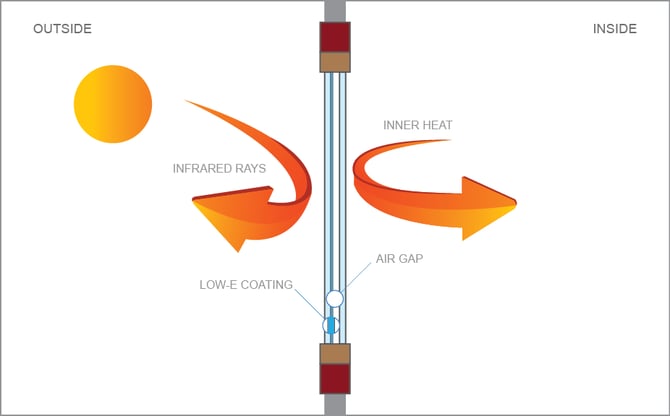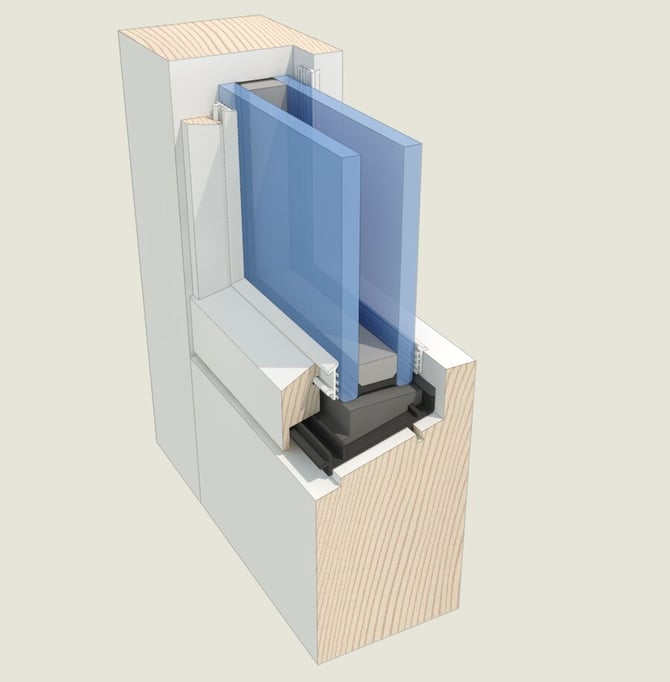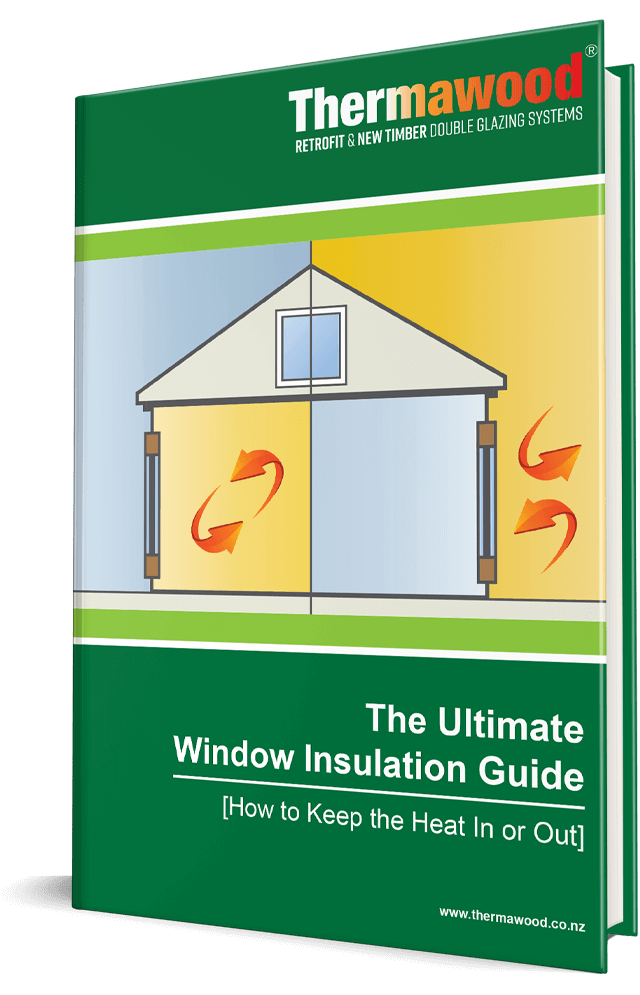Want to know how to keep a room that faces the sun cool – and in the process reduce your air conditioning bill to a pleasantly small amount?
Whether you live in a warm climate and have year-round issues or are trying to stop the summer sun from turning your home into an oven, your best option for tackling solar overheating is to address your windows, particularly those that are the most exposed to the sunlight.
This is where most of the sun’s heat energy is flooding into your home.
As much as 87% of heat gain happens through windows! This means you need sun protection for your windows.
Blocking the sunlight from hitting your windows is easier said than done. You can’t just put up lots of insulating and shading materials (nope, layering curtains, shutters and bubble wrap isn’t going to keep your home cool). You need to hone in on the culprit of uncomfortable solar heat gain – and sky-high energy bills.
An Infrared Problem Requires an Infrared Solution
Solar rays include several different types of light energy, namely infrared, ultraviolet and the visible light spectrum. It is the infrared light that creates the sun’s warming effect. When infrared light hits an object, it heats up the object. That energy doesn’t just stay in one place, it has to go somewhere. So, it radiates.
This principle is what happens when infrared light hits your window glass. It heats the glass and then starts permeating into your interior as the glass radiates its heat energy. That’s why when you try to insulate your glass with window dressings and other DIY methods, you’re effectively shading the visible light spectrum, not the infrared spectrum.
With windows that face the sun, overheating is a particular problem because they are exposed to infrared light for prolonged periods. Even with outdoor shading, you’re still getting this inbound heat energy for part of the day as the sun’s angle changes. Your solar-facing windows essentially become glass ovens, acting as ongoing heat sources for your home, whether you want them to do this or not. That is why it’s so challenging to keep a room with windows that face the sun cool; your air conditioning system has to compete against your home’s window ‘glass ovens.’
Unless, you have a solution that specifically blocks heat energy, like low E glass.
How Low E Glass Keeps Your Room Cool
Low E glass, which means low emissivity, is a special glass designed to reflect infrared energy and UV rays. It lets in the beautiful natural sunlight but stops the heat and UV radiation from entering your home. As a result, you get a cooler home, and as a bonus, your furnishings are protected from some UV exposure.

Low E glass has a microscopically thin layer on it, made from silver and other reflective materials. Heat energy and UV light bounce off of this layer. So, in the summer, the sun’s infrared and UV spectrums are reflected back outdoors. It also has the opposite effect in the winter, reflecting your home’s internal heat energy back inside.

How Low E Glass Plus Double Glazing Work Together to Keep Your House Cool
The specialised heat-blocking properties of low E glass join forces with the insulation benefits of an insulated double glazing glass unit – two panes of glass separated by a sealed air space – to create the ultimate solution for your windows: a low E double glazed window.
The double glazing unit, with two panes of glass instead of just one single pane, reduces the amount of thermal transfer – heat in the summer, cold air in the winter. In addition to the insulating impact of two panes of glass, the air space in between acts to slow down the movement of hot or cold air, essentially trapping it. This creates an even more profound insulation effect, reducing thermal transfer whilst also diminishing noise pollution by dampening incoming sound waves from entering the home. By adding argon gas inside the double glazing, the thermal value of double glazing is lifted even further.
Want to know the best part?
With modern glazing technology, you can have your windows converted with a retrofit double glazing system instead of replacing them.
Retrofitting costs about one-third of the price of getting new windows installed.

And, as you aren’t doing a full window replacement, you get to retain the original charm of your existing windows.

By using just one pane of special low E glass in the double glazing unit, it’s possible to stop the sun’s heat energy from ever penetrating the window. For windows that face the sun for most of the day, this dynamic heat blocking effect is enough to keep your house cool, even with the gorgeous sunlight streaming inside.
This means you can turn the air conditioning down, or even off, enjoy a comfortable home, a lower carbon footprint – and still enjoy your natural sunlight. That’s the beauty of science.
Whether you live in a warm climate and have year-round issues or are trying to stop the summer sun from turning your home into an oven, your best option for tackling solar overheating is to address your windows, particularly those that are the most exposed to the sunlight.
This is where most of the sun’s heat energy is flooding into your home.
As much as 87% of heat gain happens through windows! This means you need sun protection for your windows.
Blocking the sunlight from hitting your windows is easier said than done. You can’t just put up lots of insulating and shading materials (nope, layering curtains, shutters and bubble wrap isn’t going to keep your home cool). You need to hone in on the culprit of uncomfortable solar heat gain – and sky-high energy bills.
An Infrared Problem Requires an Infrared Solution
Solar rays include several different types of light energy, namely infrared, ultraviolet and the visible light spectrum. It is the infrared light that creates the sun’s warming effect. When infrared light hits an object, it heats up the object. That energy doesn’t just stay in one place, it has to go somewhere. So, it radiates.
This principle is what happens when infrared light hits your window glass. It heats the glass and then starts permeating into your interior as the glass radiates its heat energy. That’s why when you try to insulate your glass with window dressings and other DIY methods, you’re effectively shading the visible light spectrum, not the infrared spectrum.
With windows that face the sun, overheating is a particular problem because they are exposed to infrared light for prolonged periods. Even with outdoor shading, you’re still getting this inbound heat energy for part of the day as the sun’s angle changes. Your solar-facing windows essentially become glass ovens, acting as ongoing heat sources for your home, whether you want them to do this or not. That is why it’s so challenging to keep a room with windows that face the sun cool; your air conditioning system has to compete against your home’s window ‘glass ovens.’
Unless, you have a solution that specifically blocks heat energy, like low E glass.
How Low E Glass Keeps Your Room Cool
Low E glass, which means low emissivity, is a special glass designed to reflect infrared energy and UV rays. It lets in the beautiful natural sunlight but stops the heat and UV radiation from entering your home. As a result, you get a cooler home, and as a bonus, your furnishings are protected from some UV exposure.

Low E glass has a microscopically thin layer on it, made from silver and other reflective materials. Heat energy and UV light bounce off of this layer. So, in the summer, the sun’s infrared and UV spectrums are reflected back outdoors. It also has the opposite effect in the winter, reflecting your home’s internal heat energy back inside.

How Low E Glass Plus Double Glazing Work Together to Keep Your House Cool
The specialised heat-blocking properties of low E glass join forces with the insulation benefits of an insulated double glazing glass unit – two panes of glass separated by a sealed air space – to create the ultimate solution for your windows: a low E double glazed window.
The double glazing unit, with two panes of glass instead of just one single pane, reduces the amount of thermal transfer – heat in the summer, cold air in the winter. In addition to the insulating impact of two panes of glass, the air space in between acts to slow down the movement of hot or cold air, essentially trapping it. This creates an even more profound insulation effect, reducing thermal transfer whilst also diminishing noise pollution by dampening incoming sound waves from entering the home. By adding argon gas inside the double glazing, the thermal value of double glazing is lifted even further.
Want to know the best part?
With modern glazing technology, you can have your windows converted with a retrofit double glazing system instead of replacing them.
Retrofitting costs about one-third of the price of getting new windows installed.

And, as you aren’t doing a full window replacement, you get to retain the original charm of your existing windows.

By using just one pane of special low E glass in the double glazing unit, it’s possible to stop the sun’s heat energy from ever penetrating the window. For windows that face the sun for most of the day, this dynamic heat blocking effect is enough to keep your house cool, even with the gorgeous sunlight streaming inside.
This means you can turn the air conditioning down, or even off, enjoy a comfortable home, a lower carbon footprint – and still enjoy your natural sunlight. That’s the beauty of science.

[Free Guide]
Learn All About
Keeping The Heat
In or Out of Your Home

![Is It Possible to Keep a Room That Faces the Sun Cool? [Find Out]](https://www.thermawood.co.nz/wp-content/uploads/2020/11/how-to-keep-a-room-that-faces-the-sun-cool-1.png)